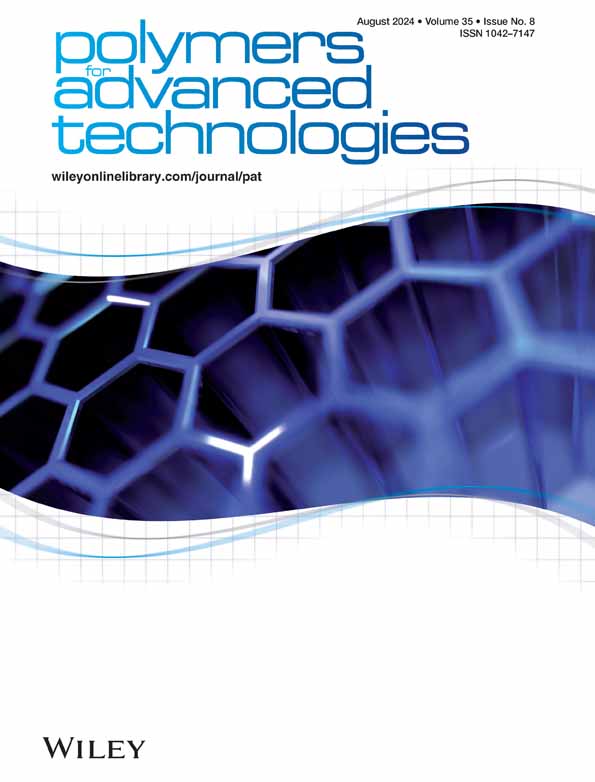Electroactive additives into polyurethanes for high corrosion resistance coatings for mild steel
IF 3.4
4区 工程技术
Q2 POLYMER SCIENCE
引用次数: 0
Abstract
There is a demand for innovative coatings such as polyurethane (PU) in industrial and commercial sectors to effectively combat corrosion on mild steel substrates. In this work, novel redox‐active polyurea (PUr) additives such as PUr‐diamine capped trimer (DCTA) and PUr‐diamine‐capped tetraaniline (DCTAni), derived from DCTA and DCTAni, were synthesized to enhance the anticorrosion properties of PU coatings. These are characterized using用于低碳钢高耐腐蚀涂层的聚氨酯电活性添加剂
工业和商业领域需要聚氨酯(PU)等创新型涂料来有效防止低碳钢基材的腐蚀。在这项工作中,合成了新型氧化还原活性聚脲(PUr)添加剂,如聚氨酯二胺封端三聚体(DCTA)和聚氨酯二胺封端四苯胺(DCTAni),这两种添加剂由 DCTA 和 DCTAni 衍生而来,可增强聚氨酯涂层的防腐性能。使用 1H 核磁共振光谱、傅立叶变换红外线和高分辨率质谱技术方法对这些添加剂进行了表征。这些添加剂(2、5 和 10 wt%)被分散在聚氨酯尿素(PUU)基质中,该基质由 PTMG-2000 和 IPDI 与己二酸二酰肼作为扩链剂合成。使用循环伏安法(CV)和紫外-可见光谱法评估了涂层的电活性。此外,还通过电化学阻抗光谱法和塔菲尔电位极化测量法评估了防腐性能。随着 PUU 中添加剂重量百分比(wt%)的增加,腐蚀保护效果达到最佳,呈现出 10% > 5% > 2% 的趋势。涂层的最大极化电阻 (Rp) 为 122.15 MΩ,腐蚀率 (CR) 低至 2.38 × 10-6 mm/年。在 5 wt% 的氯化钠盐雾中进行 600 小时的加速盐雾测试证实了涂层的耐久性。通过 FESEM 表征确定了 PUr 颗粒的微观结构。与参考 PUU 基体相比,添加剂混合 PUU 显示出适中的拉伸强度和断裂伸长率。测量了参考样品(PUU)和添加剂混合涂层的疏水性,10 wt%时的最高记录值为 93.1 ± 0.048。热重分析表明聚合物降解,在 304.1°C 时观察到最大降解 T5%。
本文章由计算机程序翻译,如有差异,请以英文原文为准。
求助全文
约1分钟内获得全文
求助全文
来源期刊

Polymers for Advanced Technologies
工程技术-高分子科学
CiteScore
6.20
自引率
5.90%
发文量
337
审稿时长
2.1 months
期刊介绍:
Polymers for Advanced Technologies is published in response to recent significant changes in the patterns of materials research and development. Worldwide attention has been focused on the critical importance of materials in the creation of new devices and systems. It is now recognized that materials are often the limiting factor in bringing a new technical concept to fruition and that polymers are often the materials of choice in these demanding applications. A significant portion of the polymer research ongoing in the world is directly or indirectly related to the solution of complex, interdisciplinary problems whose successful resolution is necessary for achievement of broad system objectives.
Polymers for Advanced Technologies is focused to the interest of scientists and engineers from academia and industry who are participating in these new areas of polymer research and development. It is the intent of this journal to impact the polymer related advanced technologies to meet the challenge of the twenty-first century.
Polymers for Advanced Technologies aims at encouraging innovation, invention, imagination and creativity by providing a broad interdisciplinary platform for the presentation of new research and development concepts, theories and results which reflect the changing image and pace of modern polymer science and technology.
Polymers for Advanced Technologies aims at becoming the central organ of the new multi-disciplinary polymer oriented materials science of the highest scientific standards. It will publish original research papers on finished studies; communications limited to five typewritten pages plus three illustrations, containing experimental details; review articles of up to 40 pages; letters to the editor and book reviews. Review articles will normally be published by invitation. The Editor-in-Chief welcomes suggestions for reviews.
 求助内容:
求助内容: 应助结果提醒方式:
应助结果提醒方式:


